The ruins of pesticides in nature and our environment; Are we doomed?
Today, I intend to leave my comfort zone once again. I have long understood that, there is more to learn if we choose to explore. Today's topic is not really new to us as it is something we virtually relate with almost every day of our life. The only issue is that, we fail to understand and realize the future repercussions. The ecosystem is large enough to accommodate all living creatures both deadly and harmless.
As we humans always strive to survive, so also do other living things, including animals and plants. It is the will to survive and produce progenies that causes a whole lot of adaptations employed by many living things. For humans, we always want comfort, so also do other creatures. Plants like weeds can very stubborn and are always ready to compete for survival against all odds.

Weed control spray
In my previous article, I discussed in detail how animals develop strategies for survival and how they deal with the threat of predators by increasing their reproductive capacity depending on the environment they find themselves.
Today, I intend to discuss the menace causes by the actions of humans in a bid to find comfort and unknowing putting their lives at risk of life threatening challenges though the use of various chemicals that are named based on living organism or plant they used on. Our focus this time around will not only be on animals but also on plants.
The war between humans and insects (pest to be precise) began long time ago, and till date, I cannot categorically say who is winning the war. Humans develop newer ways to eliminate little creatures such as insects and plants that are of no benefit to them, but as nature may have it, the more we try, the more these little creatures and plants develop resistance and become highly difficult to kill. These war may never end.
Our discussion will bother pesticides (insecticide, herbicides, rodenticides, fungicides etc.). We will be alternating both since, they actually almost perform similar functions, enjoy!
How the use of pesticides all began
Pesticides on a general note are chemicals that have ability of killing pests (an animal or insects) that cause disease or damage to farm produce. They could also be biological agents like viruses, bacteria etc that have the ability of Killing pests and weeds upon contact or ingestion.
Pesticides are generally named And classified depending on what they act on. For example, insecticides are used for eliminating insects, fungicides for fungi, rodenticides for Killin rodents, herbicides for weeds and unwanted herbs etc. So their functions is simply dependent on intent.
It is no news that the origin of agricultural practice dates back to 10,000 years ago in Mesopotamia. One of the biggest challenge they were faced with was the destructive effects of pest on their crop yields. In search for a solution and ways to handle this problem. In the quest to find the solution, it was discovered by the Sumerians that, compounds that contains sulfur could kill the pests.
Salt and some minerals were even used, but were later discontinued when it was discovered that, they mostly remained in the soil even after application. As science advanced, research helped humans to discover that even some plants naturally produced hormones and chemicals that can toxic to pest and some plants when they applied on them.
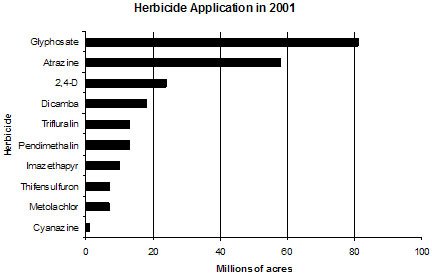
United States Environmental protection agency- Different Herbicide usage in 2001
Hence, the Sumerians were the very first people to use pesticides in history. Till date, alot of modifications has been done to pesticides and has thus produced more and more highly toxic chemicals aimed at filling the gaps and shortcomings associated with the sulphur use.
How the ruins began...
The will for insects to survive makes them evolve and most times develop resistance to chemicals such as pesticides used for their annihilation. Because they have developed this resistance, it is not surprising that humans would also want to go further to produce more toxic chemicals and by so doing, the chances of producing deadly chemicals becomes more feasible.
Insect pests are not only the living creatures that produce resistance against human actions and threat to their existence, even bacteria, fungi and viruses also follow the same pattern and all this are aimed at survival. This is where the war between humans and little creatures begins.
Pesticides generally have different mechanisms of action similarly with drugs on humans and microorganisms. When they are applied correctly and for the right insects at the right dosage, they do have maximum effects. In a situation where their application is wrongly done, it gives room for them to develop mutate and evolve to be more suited to overcome the threat subsequently.
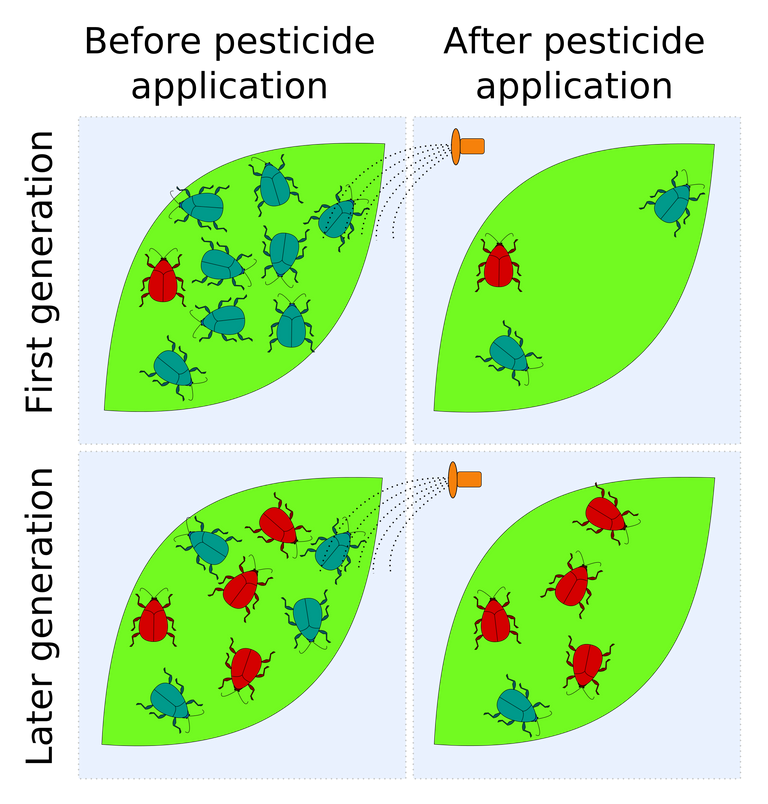
development of pesticide resistance in insects
The retaliatory response
Resistance offered by these creatures makes it hard to totally eliminate them. As s result of this, pesticides production have undergone a very interesting change beginning with the use of sulfur by the sumerians, mercy and arsenic compounds by the Chinese, salt or sea water, smokes, Tar and chemicals of plant and animal origin by Greece and Romans to Dried flowers of Pyrethrum botanically called Chrysanthemum cinerariaefolium by the Persians.
Fast forward to the 19th century, inorganic compounds were introduced for pest control. Moving forward more and more sophisticated synthetic chemicals like [Dichlorodiphenyltrichloroethane (DDT), BHC, aldrin, dieldrin, endrin, chlordane, parathion, captan and 2,4-D were later used.
The growth in synthetic pesticides accelerated in the 1940s with the discovery of the effects of DDT, BHC, aldrin, dieldrin, endrin, chlordane, parathion, captan and 2,4-D. These products were effective and inexpensive with DDT being the most popular, because of its broad-spectrum activity
When it dawned on us
DDT and some of these heavy chemicals were later banned after it was discovered to persist in the environment as this is actually where the toxicity begins. Their non biodegradability makes it possible for them to leach into soils and even contaminate water bodies.
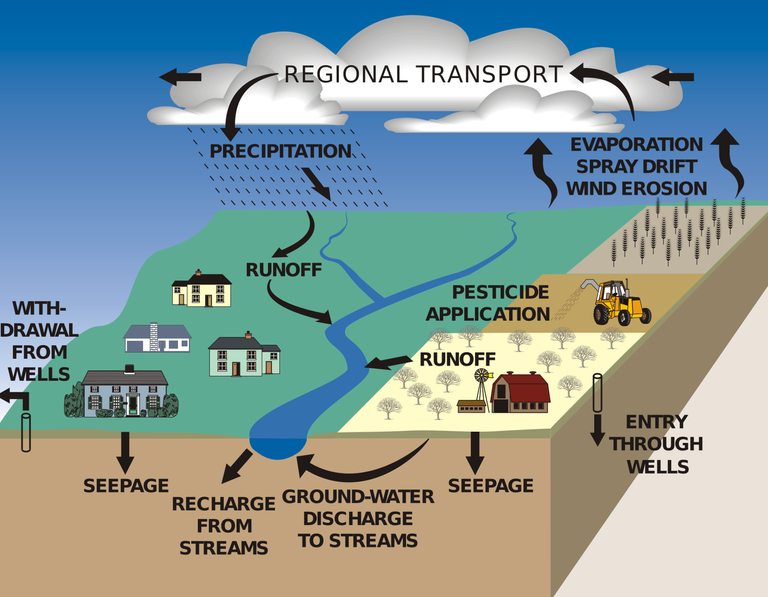
Pathways of pesticide movement in the hydrologic cycle
Till date, some of these chemicals are still in use but illegally. In some developing countries, because these chemicals are illegally imported and obviously cheap, thy are smuggled for use, but what people fail to realize is the toxic effects they have. The persistence of these chemicals in the environment was not just the only reason why it was discontinued.
Some insects were later discovered to be resistance to DDT. Even the plastic containers used to stored these chemicals are not exempted. These chemicals have the capacity of penetrating and leaching into the plastic containers used for their storage and packaging.
Where the ruins are most likely felt
In developing countries like mine, some of these containers are ignorantly used for fetching water used for domestic use and storage. There is a very high chance that some portion of the pesticides might have leaked into the water. Upon ingestion of this contaminated water, their toxicity is felt. Not only do they even persist in the environment, they also persist in animal tissue and upon continuous accumulation, they can affect the liver and to a greater extent reproduction.
Reports has it that, some of these pesticides can enter the fetal circulatory system. Should this happen at the early stage of the baby development, say during the embryogenesis stage, there is high chances that the baby will be born with congenital malformation as a result of the exposure of the mother to these chemicals. Some pesticides are able to affect developing fetus simply because they are able to pass through the placental barrier separating the mother circulatory system and that of the child.
Children are a highly susceptible population for pesticide exposure in part because of their hand-to-mouth behaviors.
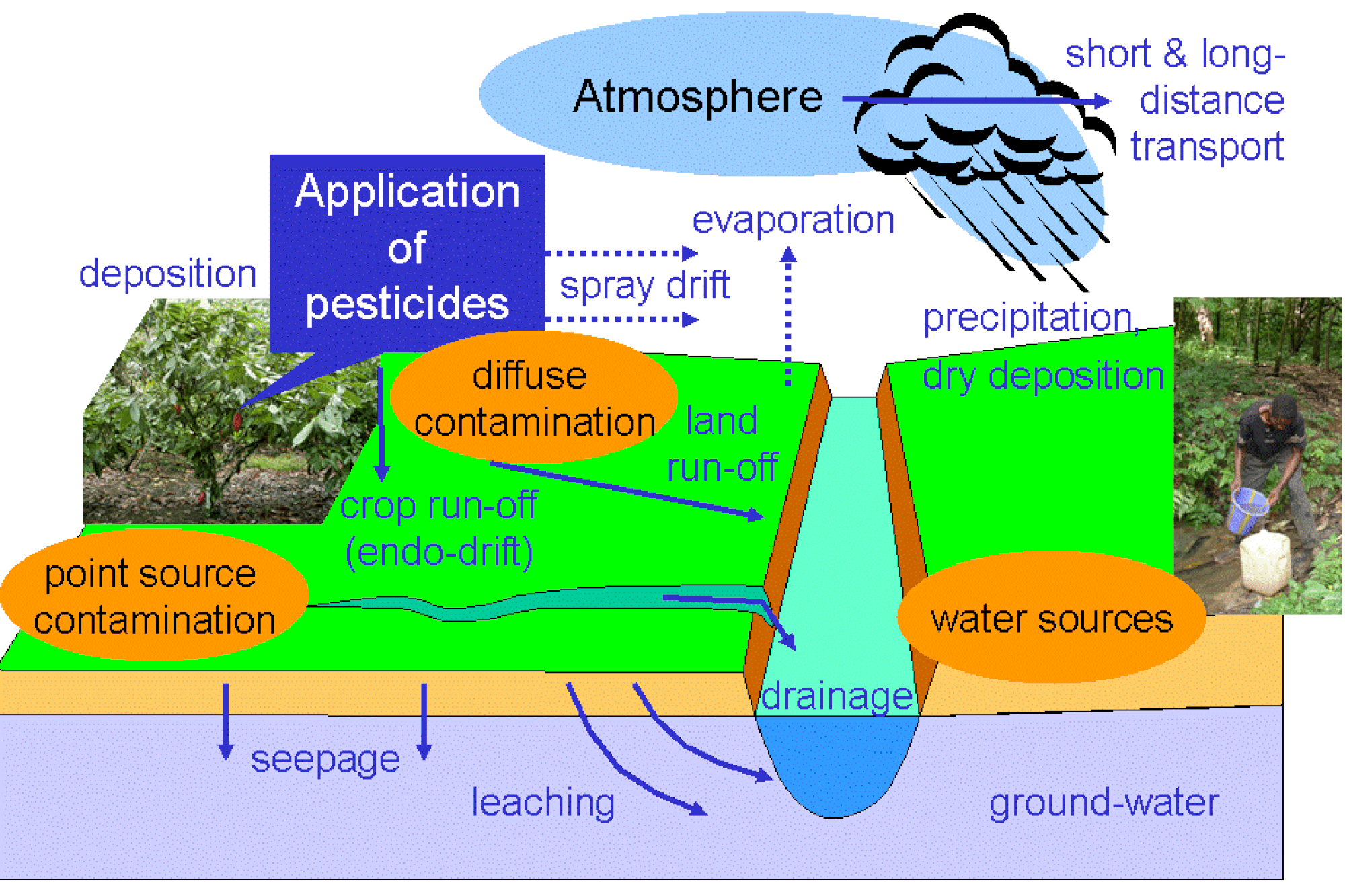
Environmental pollution by pesticides
The indiscriminate use of these pesticides was also one of the biggest challenge it faced. People ignorantly misuse these pesticides not knowing the grave consequences associated with it. I have for once heard the story of a trader in the northern part of my country who uses sniper as a pesticide. He sprays sniper directly on beans as a way of ensuring and preserving them against beans weevil. A barbaric act I must say.
To him, he ignorantly thinks he is doing the right thing but in the real sense, he preparing people for their death. I only wonder the fate of people that had already bought the beans from him before he was arrested. These are just some of the main issues surrounding pesticides usage. Because of the indiscriminate use, it has led to more advances and research. Today we now have genetically modified plants that are resistant to pest infestation. This has helped reduce the dependency on the use of pesticides.
Pest management toolbox has expanded to include use of genetically engineered crops designed to produce their own insecticides or exhibit resistance to broad spectrum herbicide products or pests. These include herbicide tolerant crops like soybeans, corn, canola and cotton and varieties of corn and cotton resistant to corn borer and bollworm respectively
The indiscriminate use of pesticides is one of the major leading cause of self poisoning especially in developing countries. Most of the pesticides used still find their way back to the eater we drink. Fishes in water are usually affected by this and also, consuming these kind of fish would result to the deposition of some of these chemicals in our body system.
You might want to have a rethink eating weird and giant sea creatures
The danger associated with eating fish or animals that do stay longer in water is that, the chances are high that, they might have accumulated a lot of toxic compounds in them. Various research have shown that these chemicals have the potential of causing cancer in humans. This is particularly associated with those pesticides that are non biodegradable e.g Organophosphates, Carbamate, Organochlorine (DDT, Chlordane) etc.
Mercury is a naturally occurring element that can be dangerous if released into the environment. It persists in the environment, and accumulates in the food chain. Human exposure can be through ingestion of seafood and freshwater fish, emissions from coal-fired power stations and metal smelters, application of mercury-containing pesticides on sugarcane and disposal of mercury containing products such as used light tubes, thermometers or dental amalgam.
One of the most widely distributed chemical contaminant of the environment is mercury. Before now, mercury was used in the production of some pesticides e.g the fungicides shirtan used in eliminating fungi that affects sugar cane. Because of the dangerous effects these chemicals has, it was outrightly banned. This reminds me of the Minamata disease saga that in the city of Minamata in Japan
The Minamata disease saga and our lessons
Minamata is a small town in Kumamoto
Prefecture on Kyushu Island in southern Japan. Fishing happened to be one the very agricultural activities they were known for and this was really in abundance. So when you talk about sea foods, they surely were the best bet.
What broke the Carmel's back was when a case of a little girl of 5 years old was reported. She had difficulty in walking and also presented with neurological signs and symptoms such as convulsion and inability to talk. Further investigation was made to find out the cause of this impairment and it was discovered that she was suffering methylmercury poisoning. How come?

The Minamata bay
As further investigation began, it was discovered that a company by name Chisso which specializes in the production of acetaldehyde, was responsible for the poisoning. The process that synthesises the acetaldehyde releases methylmercury as a byproduct. Since their drainage system was channeled into the water body, most of the methylmercury were deposited into the sea.
Since fishes are domiciled in the water, these toxic chemical were absorbed and continuously deposited in most of the fishes in the water. On consumption of these fishes by the residents and individuals in the Minamata city, they were poisoned with the methylmercury found in the fishes and sea foods. They were easily poisoned because their main primary food was fish from the sea. So it was easier for them to experience the toxicity in shorter amount of duration.
The victims of the methylmercury poisoning physically besides the earlier mentioned signs and symptoms, presented with inability to use their fingers, impaired vision, many of the children born had congenital malformation that affected their hands. After the disease was discovered, it was then named Minamata disease indicative of City from where it had its it origin or etiology.

Victim of Minamata disease
Second wave of this disease occured again but this time, in Agano River in Niigata
Prefecture. This time around, another company also in the business of producing acetaldehyde and it was the Showa Denko’s Kanose factory. Just as the Chisso factory was indicted, they also met the same fate. It was quite a big blow to the government and make me wonder, haven't we learnt our lessons? Why should history repeats m itself?
The damage has been done and the much these companies could do was to provide compensation to the farmers association. No matter the amount of compensation, it can never be enough to match up the life damaging effects these children are suffering as a result of human industrial activities. It is obvious that all the fishes in the city river would have been already loaded with the methylmercury hence, fishing activities were stopped.

The Minamata bay water pollution
Chemicals used in industrial production of pesticides do have toxicity when they are ingested. This toxicity and poisoning has always being a great challenge to human health and the environment as a whole. When will Al this chemical pollution end. As the world advances in science and technology, more as more sophisticated products are produced. A need to drastically shifted to biodegradable products is of essence.
Biopepticides (produced from plants or animals or they can even be engineered fungi, viruses, bacteria etc) have little of less effects on the environment since they are biodegradable and do not persist in the environment unlike the non biodegradable ones. This makes them relative eco friendly and favoured over other types.
Our environment as a whole is not spared from the ruins
Aside their effects on human health, they also have great negative impact on beneficial microorganisms in the soil that play significant role in maintaining balance in our ecosystem. It is no news that these pesticides, both their containers and package constitute nuisance in the society especially on water bodies.
Herbicides may cause biological impairments of water bodies if they occur in water or sediment at sufficient concentrations. Most commonly, they enter surface water in runoff or leachate, but, because they have relatively low toxicity to fish and invertebrates. Acute toxicity is likely only when they are deliberately or accidentally applied directly to water bodies
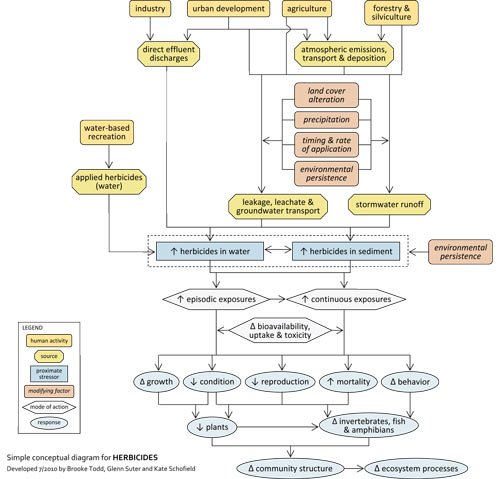
A simple conceptual diagram, depicting pathways from sources to impairments, related to herbicides
The intentional application of pesticides on soils have great impact doesn't not only have impact on the insect pest and weeds, most times their effects are long felt since they are persistent in the soil. In addition to killing weeds, they also kill insects and some microorganisms of environmental benefits. Eve though most of the pesticides that caused serious imbalance in the ecosystem have been banned, their effects still persist.
For example, most plants depend on the activity of some bacteria to convert atmospheric nitrogen into nitrates - the usable form of nitrogen by plants. Reports have shown that herbicides, e.g glyphosate and triclopyr reduce reduce the growth and activity of free-living nitrogen-fixing bacteria in soil and inhibits soil bacteria that transform ammonia into nitrite respectively
If all these important microorganisms are eliminated as a result of human industrial and agricultural activities, what will be our fate. Since the effects of these pesticides live stay long. What will be the fate of generations to come. The ruins will remain long after we are gone.
The need to really find ways to ameliorate the mess we have created is of utmost importance. Even if we forget, nature never forgets. Eco friendly activities are what we have to start thinking. Every industrial activity we intend to engage in should be the environment friendly type. Most of our beneficial insects like the bees, butterfly, moths helps most plants to fertilize and bear fruits. If these insects are killed as results of the pesticides, our food chain will suffer.
If the rate at which industrial activities that produce pollutants continue without any remedy and way to curtail them, it's just a matter of time before nature revolts. It has already started with green house effects and global earth warming. Who knows what is to come next.
Protect the environment by stopping indiscriminate use of pesticides.
Thanks for reading, till I come your way again.
References
•Chronic Poisoning : Trace Metals and Others
•Modes of Action of Different Classes of Herbicides
•Minamata Convention on Mercury and Pesticides
•Pesticides
•Herbicides
•Pesticides and Herbicides, Types, Uses, and Determination of Herbicides
•History of pesticides use
•Exposure Assessment Tools by Chemical Classes - Pesticides
•Impact of pesticides use in agriculture: their benefits and hazards
•General Information on the Risk of Eating Fish - Seafood and Aquatic Life
•What is the greenhouse effect?
In the U. S. it is common to hear politicians rail against 'regulations'. These are seen as a choke hold on business and development. The short term of the financial balance sheet is the focus. At the same time, groups lobby for more money to find a cure for cancer. Nobody makes the connection. Nobody wants to take the hard road that will save lives in the long run.
Thanks for a great blog.
Exactly, most times it's all about their personal gains momentarily. We fail to look at the future consequences.
They pump in more money for research but still cannot decisively do away with the potential causes. We remain in the same loop damage-repair efforts.
Thanks for the read and compliment 💖
Thanks for your contribution to the STEMsocial community. Feel free to join us on discord to get to know the rest of us!
Please consider delegating to the @stemsocial account (85% of the curation rewards are returned).
Thanks for including @stemsocial as a beneficiary, which gives you stronger support.
Unfortunately, a lot of damage has already been done. It is important to educate people to try to fix things as much as possible, and preserve what is left. I am however very skeptical about out ability as a species to handle that... Hopefully I am wrong...
Cheers, and thanks for this nice blog that I only read now (the distilled showed me the way ;) ).
It will be really difficult to handle Indeed.
It is easier to scatter than to rebuild.
Hopefully if we retrace our steps, we could still win.
That's true, but very little time is left according to estimates... You seem more optimistic than I am ;)